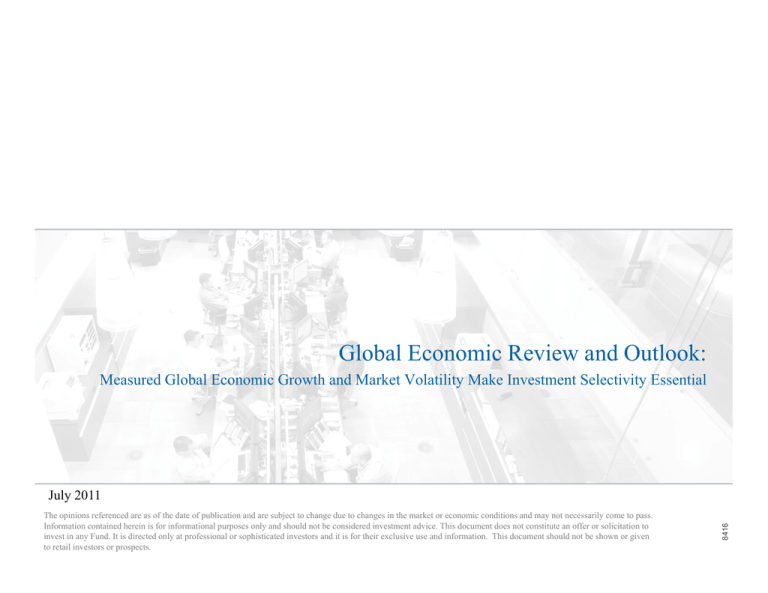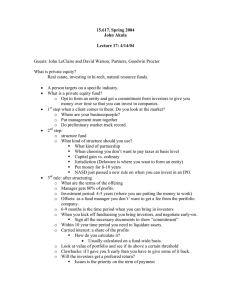
Global Economic Review and Outlook:
Measured Global Economic Growth and Market Volatility Make Investment Selectivity Essential
The opinions referenced are as of the date of publication and are subject to change due to changes in the market or economic conditions and may not necessarily come to pass.
Information contained herein is for informational purposes only and should not be considered investment advice. This document does not constitute an offer or solicitation to
invest in any Fund. It is directed only at professional or sophisticated investors and it is for their exclusive use and information. This document should not be shown or given
to retail investors or prospects.
8416
July 2011
Legal Disclosure
While the information contained herein has been obtained from sources believed to be reliable, Calamos
International LLP makes no representations as to the accuracy or completeness of this information and accepts
no liability in relation to its use. Past performance is not indicative of future results. This document constitutes
neither an offer nor solicitation to p
purchase or sell securities or any
y other financial instruments. This material is
provided to you because you have been classified as a professional client or eligible counterparty by Calamos
International LLP as defined under the Financial Services Authority's rules. If you are unsure about your
classification, or believe that you may be a retail client under these Rules, please contact Calamos International
LLP and disregard this information. Calamos International LLP, is a limited liability partnership organized in the
UK and authorized by the FSA to provide investment advisory and product distribution services
services. Investment
management services and certain related relationship services will be delegated to Calamos Advisors LLC,
which is based in the U.S. and registered with the SEC.
With regards to portfolio management,
management investment strategy and process,
process and investment team,
team the following
responses are with reference to Calamos Advisors LLC. The employees of Calamos’ major business functions,
including management, investment personnel and trading are employed by Calamos Advisors LLC and based in
the U.S.
This document does not constitute an offer or solicitation to invest in any Fund. It is directed only at professional or sophisticated investors and it is for their exclusive use and
information. This document should not be shown or given to retail investors or prospects.
8416
The Funds are offered solely to non-U.S. investors under the terms and conditions of the Fund’s current
prospectus. The prospectus contains important information about the Fund and should be read carefully before
investing. A copy of the full and simplified prospectus for the Fund may be obtained by visiting
calamosglobal.com, or by contacting the local Paying Agent listed by jurisdiction at calamosglobal.com, or
th
through
h the
th Fund’s
F d’ Transfer
T
f Agent,
A t State
St t Street
St t Fund
F d Services
S i
(Ireland)
(I l d) Limited.
Li it d
Waiting for the World to Change
As of 6/30/11
YEAR TO DATE MARKET PERFORMANCE
6%
6.0%
5.4%
>
Determining a proper asset
allocation in today’s market
environment is challenging
as macro issues and high
correlations are prevalent.
>
Global markets are more
correlated than at any other
ti since
time
i
the
th 1970s.
1970
5.0%
4%
3 1%
3.1%
2.7%
2%
1.0%
0%
S&P 500
MSCI EAFE
Source: Mellon Analytical Solutions LLC
Nasdaq
U.S. Treasury
10-Year
S&P GSCI
MSCI EM
CORRELATIONS OF EVERYTHING: S&P 500 INDEX
This document does not constitute an offer or solicitation to invest in any Fund. It is directed only at professional or sophisticated
investors and it is for their exclusive use and information. This document should not be shown or given to retail investors or
prospects.
8416
Source: The Leuthold Group / Average, trailing 2-yr correlation of weekly % changes in the S&P 500 Index with weekly % changes
in: Nasdaq Composite, MSCI EAFE Index, S&P GSCI (Commodity markets), Gold, 10-year U.S. T-Bond Yield, U.S. Tradeweighted $
Global Landscapes Remain Diverse
As of 6/30/11
IMPLIED VOLATILITY (%)
35
30
>
China continues to fight
inflation, raising rates for the
fourth time and potentially
nearing
i the
h endd off its
i
tightening cycle
>
Sovereign debt worries in
Europe continue to plague
markets and test the
resilience of the euro.
>
Near-term, we believe that
market volatility will remain
elevated, but double-dip
recession is unlikely.
25
20
15
10
5
0
Jan-11
Feb-11
Mar-11
Apr-11
May-11
U.S.
Emerging Markets
Jun-11
Jul-11
Source: Bloomberg. U.S. volatility represented by the CBOE VIX. Emerging Markets volatility represented by the JP
Morgan Emerging Market Volatility Index (VXY)
TWO SPEED GLOBAL RECOVERY…
Projected 2011 GDP Growth
Projected 2011 Inflation*
United States
2.5%
2.2%
Brazil
4.1%
6.3%
Germanyy
3.2%
2.2%
Greece
-3.0%
2.5%
-0.7%
0.2%
Americas
Euro Zone
Asia
Emerging Asia
China
9.6%
5.0%
India
8.2%
7.5%
*Consumer Price
Index as
indicator for
inflation
Source: IMF
This document does not constitute an offer or solicitation to invest in any Fund. It is directed only at professional or sophisticated
investors and it is for their exclusive use and information. This document should not be shown or given to retail investors or
prospects.
8416
Japan
Surges in Government Public Debts and Their Resolution
ADVANCED ECONOMIES AND EMERGING MARKETS, 1900-2011
>
>
As of 6/30/11
Global markets focused on
uncertainty surrounding
macro issues, such as:
>
Oil prices
>
Sovereign debt and global
bank crises
>
Fed policy
>
Emerging market inflation &
China’s growth
>
Global exchange rates
>
Market volatility
Global economies are more
prone to government action
than in the past.
This document does not constitute an offer or solicitation to invest in any Fund. It is directed only at professional or sophisticated
investors and it is for their exclusive use and information. This document should not be shown or given to retail investors or
prospects.
8416
Sources: Reinhart (2010), Reinhart and Rogoff (2009 and 2011).
United States Must Address Imbalances
As of 6/30/11
FEDERAL GOVERNMENT RECEIPTS AND EXPENDITURES AS A % OF GDP
1Q 1947 – 1Q 2011
>
Federal budget has seen frequent
deficits since the ‘70s.
>
On average, spending rose from
18% to 22% of GDP since early
‘70s. Tax receipts have remained
stable at 18% of GDP, despite
varied tax rates over this time
period.
>
The low yield of the 10-year U.S.
Treasury and longer government
debt reflects economic g
growth
rates—yield on10-year note
approximates nominal growth of
the economy.
Source: Federal
Reserve Bank
of St. Louis
TOTAL U
U.S.
S DEBT TO NOMINAL GDP VS
VS. 10
10-YEAR
YEAR BOND YIELD
Source:
Bloomberg
and Federal
Reserve Bank
of St. Louis
This document does not constitute an offer or solicitation to invest in any Fund. It is directed only at professional or sophisticated
investors and it is for their exclusive use and information. This document should not be shown or given to retail investors or
prospects.
8416
1Q 1962 – 4Q 2010
Productivity Trends Have Shifted over the Last Decade
PRODUCTIVITY TRENDS
As of 6/30/11
>
Although labor productivity has
been quite strong over the past
decade, the productivity of
capital has deteriorated.
>
Capital is less productive due to:
>
>
Overbuilt retail & housing stock
>
More productive manufacturing
infrastructure
>
Closing of plants in the U
U.S.
S
during the last decade
This makes GDP growth more
challenging in the U.S.
This document does not constitute an offer or solicitation to invest in any Fund. It is directed only at professional or sophisticated
investors and it is for their exclusive use and information. This document should not be shown or given to retail investors or
prospects.
8416
Source: Bureau of Labor Statistics, U.S. Department of Labor
Total Investment in the U.S. GDP Has Declined
As of 6/30/11
Source: Bloomberg
This document does not constitute an offer or solicitation to invest in any Fund. It is directed only at professional or sophisticated
investors and it is for their exclusive use and information. This document should not be shown or given to retail investors or
prospects.
>
Shrinking manufacturing
sector and changing
composition of global
economy continues to
challenge sustainable global
GDP.
>
While global infrastructure
spending is expected to climb
and support global GDP, it is
difficult to understand how
developed markets can afford
additional spending without
addressing key issues.
8416
TOTAL FIXED INVESTMENT IN U.S. GDP
The Global Recovery Continues to Develop
WORLD TRADE VOLUME AND WORLD EQUITY MARKETS
As of 6/30/11
> While growth
remains
dependent on emerging
market economies,
economies world
trade and industrial
production hit all time highs.
This document does not constitute an offer or solicitation to invest in any Fund. It is directed only at professional or sophisticated
investors and it is for their exclusive use and information. This document should not be shown or given to retail investors or
prospects.
8416
Sources: Netherland Bureau for Economic Policy Analysis, Bloomberg
Financial Asset Valuations: The Fed Model
FED MODEL* VS. THE ACTUAL S&P 500 INDEX LEVEL
As of 6/30/11
> Abnormally
low interest rates
in developed world do not
appear to be discounted in
equity values.
> Old
Fed Model discounted
market earnings at inverse of
the 10-year Treasury (today
that would mean earnings
would trade at a multiple
above 30X, or more than
twice today’s level).
The Fed Model is the S&P 500 Index’s earnings per share, multiplied by the inverse of the
10-Year Treasury rate.
This document does not constitute an offer or solicitation to invest in any Fund. It is directed only at professional or sophisticated
investors and it is for their exclusive use and information. This document should not be shown or given to retail investors or
prospects.
> Equity
i markets
k
have
h
priced
i d in
i
a different environment and
provide a better risk-reward
than fixed income or
commodity
di indexes.
i d
8416
Source: Calamos, Bloomberg and Federal Reserve Bank of St. Louis.
Valuations Are Compelling in Equity Markets
As of 6/30/11
Source: Bloomberg
>
Emerging market valuations
relative to developed markets
are currently above historical
averages.
>
Valuations for growth
companies remain at
attractive levels.
>
Since 1980, approximately
53% of market value came
from future cash flows.
Currently, only 38% is
derived from cash flow
component.
>
Valuations remain at levels
not seen in more than 20
years.
MEDIAN % MARKET VALUE BASED ON FUTURE CASH FLOWS
Sources:
Calamos
Advisors LLC,
Model Station
and the Federal
Reserve Bank of
St. Louis
i
This document does not constitute an offer or solicitation to invest in any Fund. It is directed only at professional or sophisticated
investors and it is for their exclusive use and information. This document should not be shown or given to retail investors or
prospects.
8416
VALUATIONS OF MSCI EM INDEX RELATIVE TO MSCI WORLD INDEX
Multinationals Continue to Tap into Global Marketplace
Non-U.S.
Revenues 2010
Exxon
69%
66%
Apple
46%
62%
Chevron
34%
58%
IBM
58%
64%
General Electric
41%
53%
Johnson & Johnson
42%
52%
AT&T
0%
0%
Proctor & Gamble
50%
58%
Microsoft
33%
42%
JP Morgan
36%
22%
Source: Bloomberg;
Company 10K
>
On average, more than 50%
of revenue of the S&P 500
constituents comes from
outside the U.S.
>
Non U.S.
Non-U
S revenues have seen
superior margins for past
decade. Geographically
diversified revenue streams
should also benefit from less
volatility.
>
More revenue stability and
superior margins suggests
higher valuations for U.S.
multinationals.
PRETAX MARGINS FOR S&P500 NON FINANCIALS WITH >25% FOREIGN
SALES (1995-2010)
Source:
FactSet/Compustat,
BofA ML U.S. Equity
Strategy
This document does not constitute an offer or solicitation to invest in any Fund. It is directed only at professional or sophisticated
investors and it is for their exclusive use and information. This document should not be shown or given to retail investors or
prospects.
8416
Non-U.S.
Revenues 2000
S&P 500 Largest
Companies
As of 6/30/11
Global Economic Review & Outlook
As of 6/30/11
OUR PERSPECTIVE:
Measured Global Economic Growth
>
Double-dip recession unlikely in the near-term
>
M d t economic
Moderate
i growth
th probable
b bl for
f developed
d l d markets,
k t stronger
t
growth
th likely
lik l ffor EM
>
Expect a rotation to more stable, lower risk, less cyclical sectors
>
Key economic indicators (ISM and ECRI) have slowed measurably
>
Weak consumer spending and employment; housing market making new lows
Challenges for World Economies and Financial Markets
>
Multiple EU financial crises and QE2 end—test strength of equity and bond market valuations
>
Inflation concerns (and growth) in emerging markets
>
Housing market improvement via lower prices, less debt burden and better job growth
>
Potential leadership changes and policy changes to address economic, fiscal and monetary situations
>
G
Growth
h stocks
k especially
i ll attractive;
i cheapest
h
valuations
l i
we have
h
seen in
i more than
h 20 years
>
High yield spreads may be vulnerable to rate increases; Bond market vulnerable to inflation
>
Growth of global middle class consumption favors companies with global brands and global footprint
>
Investment selectivity and active management is essential
This document does not constitute an offer or solicitation to invest in any Fund. It is directed only at professional or sophisticated investors and it is for their exclusive use and
information. This document should not be shown or given to retail investors or prospects.
8416
Volatility Creates Opportunity
> Equity valuations in U.S. still favorable; seemed to have factored in increasing interest rates
Additional Disclosure
As of 6/30/11
The opinions referenced are as of the date of publication and are subject to change due to changes in the market or economic conditions and may not
necessarily come to pass. Information contained herein is for informational purposes only and should not be considered investment advice.
The PMI Composite Index is an indicator of the economic health of the manufacturing sector. The index is based on five major indicators: new
orders inventory levels,
orders,
levels production,
production supplier delivers and the employment environment.
environment The S&P Mid-Cap 400 Index is an unmanaged index
generally representative of the market for the stocks of mid-sized U.S. companies. The Standard & Poor’s 500 Stock Index (S&P 500) is an
unmanaged index generally representative of the U.S. Stock Market, without regard to company size. S&P GSCI Index is a composite index of
commodity sector returns that represent a broadly diversified, unleveraged, long-only position in commodity futures. The ECRI is an index, released
each Friday by the Economic Cycle Research Institute, that identifies turning points in the economic cycle that are indicated by pronounced changes
in the index. The index contains money supply data, stock prices, an industrial markets price index developed by the organization, mortgage
applications,
li ti
bond
b d quality
lit spread,
d bond
b d yields,
i ld andd initial
i iti l jobless
j bl claims.
l i
The
Th ISM Manufacturing
Man fact ring Prices Paid Index
Inde is
i a national
ti l manufacturing
f t i
index based on a survey of purchasing executives at roughly 300 industrial companies. Signals expansion when the PMI is above 50 and contraction
when below. The MSCI Emerging Markets Index is a free float-adjusted market capitalization index that is designed to measure equity market
performance of emerging markets. The MSCI Emerging Markets Index consisted of the following 21 emerging market country indices: Brazil,
Chile, China, Colombia, Czech Republic, Egypt, Hungary, India, Indonesia, Korea, Malaysia, Mexico, Morocco, Peru, Philippines, Poland, Russia,
South Africa, Taiwan, Thailand, and Turkey. Unless otherwise noted, index returns reflect the reinvestment of income dividends and capital gains, if
any, but
b do
d not reflect
fl fees,
f
brokerage
b k
commissions
i i
or other
h expenses off investing.
i
i
I
Investors
may not make
k di
direct investments
i
into
i
any index.
i d
Sectors and Countries mentioned are presented to illustrate sectors and countries in which a portfolio may invest. Portfolio holdings are subject to
change daily. Investments in overseas markets pose special risks, including currency fluctuation and political risks, and the portfolio is expected to
be more volatile than that of a U.S. only portfolio. These risks are generally intensified for investments in emerging markets.
Treasury securities are bonds issued by the U.S. Treasury. They are the debt finance instruments of the federal government, and are often referred to
as treasuries.
Calamos Global Funds PLC
RBC Dexia Investor Services (Ireland) Limited
Georges Quay House / 43 Townsend Street
D bli 2 / Ireland
Dublin
I l d
Tel: (353) 1 440 6555 Fax: (353) 1 613 0401
calamosglobal.com
E-mail: calamos-dealing-team@statestreet.com
Calamos Financial Services, LLC Distributor
2020 Calamos Court, Naperville, IL 60563-2787
Tel: (800) 582 6959
www.calamos.com
l
E-mail: caminfo@calamos.com
© 2011 Calamos Holdings LLC. All Rights Reserved. Calamos® and Calamos Investments® are registered trademarks of Calamos Holdings LLC.
This document does not constitute an offer or solicitation to invest in any Fund. It is directed only at professional or sophisticated investors and it is for their exclusive use and
information. This document should not be shown or given to retail investors or prospects.
8416
Calamos International LLP
No1 Cornhill,
London, EC3V END, UK
Tel: +44 (0)20 3178 8841
www.calamosgolobal.com
Calamos International LLP Distributor is authroized
and regulated by the Financial Services Authority







